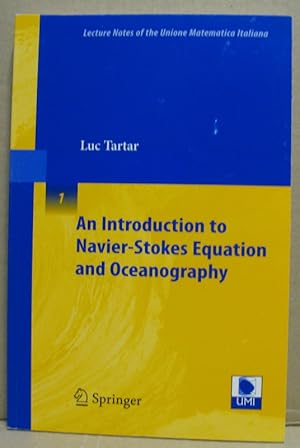introduction navier stokes equation oceanography von tartar luc (4 Ergebnisse)
Suchfilter
Produktart
- Alle Product Types
- Bücher (4)
- Magazine & Zeitschriften (Keine weiteren Ergebnisse entsprechen dieser Verfeinerung)
- Comics (Keine weiteren Ergebnisse entsprechen dieser Verfeinerung)
- Noten (Keine weiteren Ergebnisse entsprechen dieser Verfeinerung)
- Kunst, Grafik & Poster (Keine weiteren Ergebnisse entsprechen dieser Verfeinerung)
- Fotografien (Keine weiteren Ergebnisse entsprechen dieser Verfeinerung)
- Karten (Keine weiteren Ergebnisse entsprechen dieser Verfeinerung)
- Manuskripte & Papierantiquitäten (Keine weiteren Ergebnisse entsprechen dieser Verfeinerung)
Zustand Mehr dazu
- Neu (2)
- Wie Neu, Sehr Gut oder Gut Bis Sehr Gut (Keine weiteren Ergebnisse entsprechen dieser Verfeinerung)
- Gut oder Befriedigend (1)
- Ausreichend oder Schlecht (Keine weiteren Ergebnisse entsprechen dieser Verfeinerung)
- Wie beschrieben (1)
Einband
- alle Einbände
- Hardcover (Keine weiteren Ergebnisse entsprechen dieser Verfeinerung)
- Softcover (4)
Weitere Eigenschaften
- Erstausgabe (1)
- Signiert (Keine weiteren Ergebnisse entsprechen dieser Verfeinerung)
- Schutzumschlag (Keine weiteren Ergebnisse entsprechen dieser Verfeinerung)
- Angebotsfoto (4)
Sprache (2)
Gratisversand
- Kostenloser Versand nach USA (Keine weiteren Ergebnisse entsprechen dieser Verfeinerung)
Land des Verkäufers
Verkäuferbewertung
-
An Introduction to Navier-Stokes Equation and Oceanography.
Buch 1 von 26: Lecture Notes of the Unione Matematica ItalianaVerlag: Springer Berlin Heidelberg., 2006
ISBN 10: 3540357432 ISBN 13: 9783540357438
Sprache: Englisch
Anbieter: Universitätsbuchhandlung Herta Hold GmbH, Berlin, Deutschland
2006th ed. 15 x 23 cm. 247 pages. Paperback. Versand aus Deutschland / We dispatch from Germany via Air Mail. Einband bestoßen, daher Mängelexemplar gestempelt, sonst sehr guter Zustand. Imperfect copy due to slightly bumped cover, apart from this in very good condition. Stamped. Sprache: Englisch.
-
An Introduction to Navier-Stokes Equation and Oceanography. (Lecture Notes of the Unione Mathematica Italiana 1)
Verlag: Springer-Verlag, Berlin, Heidelberg, New York, 2006
ISBN 10: 3540357432 ISBN 13: 9783540357438
Erstausgabe
Zustand: Gut. 1. Aufl.;. Gr.8° 245 pages; Orig.-Broschur; 410g; [Deutsch]; fine 1. Auflage; [lgr=T] _ x2x_. BUCH.
-
An Introduction to Navier-Stokes Equation and Oceanography
Buch 1 von 26: Lecture Notes of the Unione Matematica ItalianaVerlag: Springer Berlin Heidelberg, 2006
ISBN 10: 3540357432 ISBN 13: 9783540357438
Sprache: Englisch
Anbieter: moluna, Greven, Deutschland
EUR 59,12
EUR 48,99 für den Versand von Deutschland nach USAAnzahl: Mehr als 20 verfügbar
In den WarenkorbKartoniert / Broschiert. Zustand: New. Based on a Carnegie Mellon University graduate course in mathematicsIncludes comments and biographical briefs added to original lecture notesTeaches a critical point of view concerning the partial differential equations of continuum mechani.
-
An Introduction to Navier-Stokes Equation and Oceanography
Buch 1 von 26: Lecture Notes of the Unione Matematica ItalianaVerlag: Springer, Berlin, Springer Berlin Heidelberg, Springer, 2006
ISBN 10: 3540357432 ISBN 13: 9783540357438
Sprache: Englisch
Anbieter: AHA-BUCH GmbH, Einbeck, Deutschland
Taschenbuch. Zustand: Neu. Neuware - In the spring of 1999, I taught (at CARNEGIEMELLON University) a graduate course entitled Partial Di erential Equations Models in Oceanography, and I wrote lecture notes which I distributed to the students; these notes were then made available on the Internet, and they were distributed to the participants of a Summer School held in Lisbon, Portugal, in July 1999. After a few years, I feel it will be useful to make the text available to a larger audience by publishing a revised version. To an uninformed observer, it may seem that there is more interest in the Navier-Stokes equation nowadays, but many who claim to be interested show such a lack of knowledge about continuum mechanics that one may wonder about such a super cial attraction. Could one of the Clay Millennium Prizes bethereasonbehindthisrenewedinterest Readingthetextoftheconjectures to be solved for winning that particular prize leaves the impression that the subject was not chosen by people interested in continuum mechanics, as the selected questions have almost no physical content. Invariance by translation or scaling is mentioned, but why is invariance by rotations not pointed out 1 andwhyisGalileaninvariance omitted,asitistheessentialfactwhichmakes 1 Velocities involved for ordinary uids being much smaller than the velocity of light c, no relativistic corrections are necessary and Galilean invariance should then be used, but one should be aware that once the mathematical equation has been written it is not automatic that its solutions will only use velocities bounded by c.





